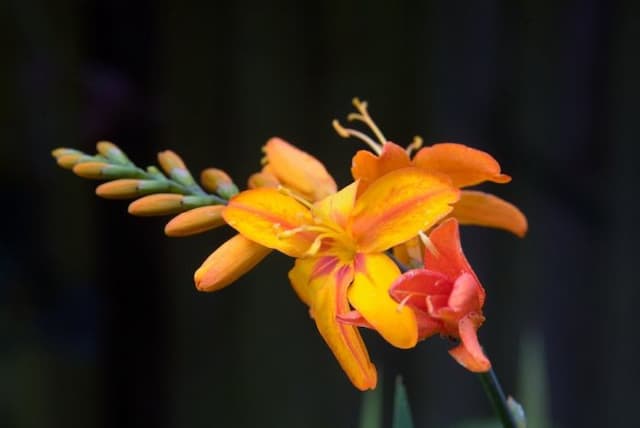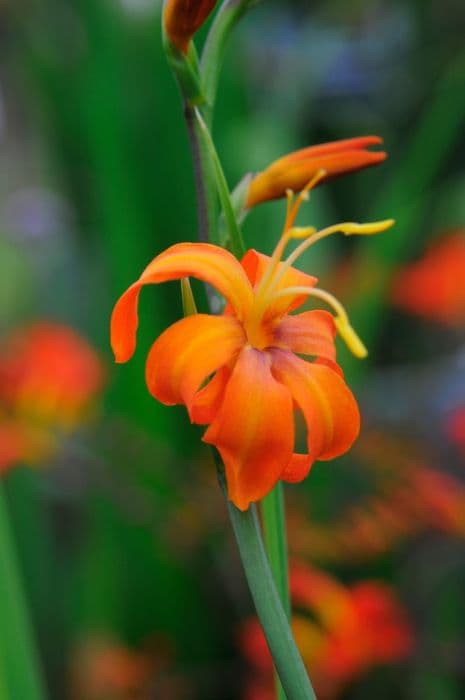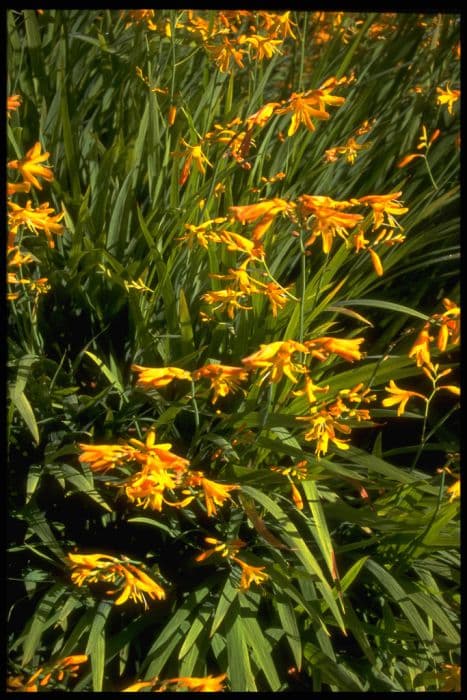Chilean Iris Libertia chilensis Formosa Group

ABOUT
Libertia chilensis, commonly known as Chilean iris, is an evergreen perennial that has a distinct and attractive appearance characterized by its strap-like, bright green leaves which are stiff and upright, forming a tidy clump or tuft. The foliage creates an elegant architectural presence in the garden, with leaves that can sometimes show an orange or bronzy tinge under certain conditions. During its blooming period, the Chilean iris bears an abundance of dainty yet conspicuous white flowers. These blossoms are typically small and star-shaped, carried on slender, stiff stems that rise vertically, interspersed among the foliage. The flowers possess a gentle beauty with a subtle contrast against the green leaves, often attracting bees and butterflies to the garden. Following the flowering period, the plant develops seed pods that also add to the ornamental value of the Chilean iris. These pods can become quite ornate as they mature, turning from green to a brown or blackish color and often persisting into winter, providing visual interest even when the flowers have faded. Altogether, the Chilean iris exudes a simple yet striking charm, with its year-round foliage and seasonal blossoms adding a touch of elegance and grace to the landscape. The contrast between the verdant foliage and the delicate white flowers makes it a sought-after choice for gardeners looking to create a natural yet structured garden display.
About this plant
 Names
NamesFamily
Iridaceae
Synonyms
Chilean Iris, New Zealand Satin Flower
Common names
Libertia formosa, Libertia chilensis.
 Toxicity
ToxicityTo humans
There is no significant evidence to suggest that the Chilean Iris, the most common common name of Libertia chilensis Formosa Group, is toxic to humans. Generally, it is not listed as a poisonous plant, and there are no well-documented cases of poisoning from ingesting this plant. However, as with any plant not commonly used for food, it's always possible to have a personal allergic reaction or sensitivity, so it's advisable not to ingest plant material that is not known to be safe. If a person suspects they are having a reaction after ingesting parts of the plant, they should seek medical advice.
To pets
There is no widespread documentation of toxicity of the Chilean Iris, the most common common name of Libertia chilensis Formosa Group, to pets such as dogs or cats. This plant is not typically listed among plants that are poisonous to pets and there are no prevalent reports of pet poisonings attributed to it. Nevertheless, individual pets may have sensitivity or allergic reactions to non-toxic plants. If a pet owner suspects their animal is unwell after consuming any part of the plant, it is prudent to consult a veterinarian.
 Characteristics
CharacteristicsLife cycle
Perennials
Foliage type
Evergreen
Color of leaves
Green
Flower color
White
Height
2 feet [60 cm]
Spread
2 feet [60 cm]
Plant type
Herb
Hardiness zones
8
Native area
Chile
Benefits
 General Benefits
General Benefits- Ornamental Appeal: Libertia chilensis Formosa, commonly known as Chilean iris, adds aesthetic value to gardens with its striking green foliage and white flowers.
- Low Maintenance: Once established, the Chilean iris requires minimal care, making it suitable for low-maintenance landscapes.
- Drought Tolerance: It is drought-resistant and can thrive in dry conditions once it's well-rooted, suitable for water-wise gardening.
- Soil Adaptability: This plant can adapt to a variety of soil conditions, though it prefers well-drained sites.
- Attracts Pollinators: The flowers of the Chilean iris attract bees and other pollinators, supporting biodiversity.
- Year-Round Interest: Evergreen in many climates, it provides visual interest throughout all seasons with its foliage and seasonal blooms.
- Erosion Control: Its root system helps stabilize soil, thus preventing erosion on slopes and in garden beds.
- Wildlife Habitat: It offers shelter and food for wildlife, including birds and insects.
 Medical Properties
Medical PropertiesThis plant is not used for medical purposes.
 Air-purifying Qualities
Air-purifying QualitiesThis plant is not specifically known for air purifying qualities.
 Other Uses
Other Uses- As a natural dye: The fibrous parts of the Libertia chilensis plant can be used to extract a natural dye for coloring textiles.
- In basketry: The tough, fibrous leaves of Libertia chilensis can be woven into baskets and other traditional crafts.
- Garden accent: With its striking foliage, Libertia chilensis can be used as a focal point or accent in landscape design.
- Floral arrangements: The long-lasting flowers and seed pods of Libertia chilensis make it a unique addition to cut floral arrangements.
- In ponds and water features: Libertia chilensis can be planted around ponds or water features for an attractive, architectural shoreline plant.
- Erosion control: Its dense root system can help stabilize soil in areas prone to erosion.
- Photography subject: The unique form and vibrant green color of the plant make it an interesting subject for nature photographers.
- Educational tool: Libertia chilensis can be used to teach botany and plant identification in educational settings.
- Insect habitat: The plant can provide shelter and food for beneficial insects, contributing to garden biodiversity.
- Theme gardens: It can be included in native plant gardens or xeriscape landscapes to showcase plants that thrive with minimal water requirements.
Interesting Facts
 Feng Shui
Feng ShuiThe plant Libertia is not used in Feng Shui practice.
 Zodiac Sign Compitability
Zodiac Sign CompitabilityThe plant Libertia is not used in astrology practice.
 Plant Symbolism
Plant Symbolism- Resilience: Libertia chilensis, commonly known as Chilean Iris, often grows in rough soil conditions and climates, which symbolizes the ability to endure and adapt to challenging environments.
- Purity: The white flowers of the Chilean Iris are often associated with purity and innocence, making it a symbol of clean and unblemished beauty.
- Freedom: The plant's name "Libertia" is derived from the Latin word for freedom ("libertas"), embodying the spirit of liberty and independent growth.
 Water
WaterChilean iris needs to be watered regularly to maintain moist, but not waterlogged, soil. It is best to water this plant deeply once a week, allowing for the top inch of soil to dry out between waterings. During the growing season in spring and summer, you may need to increase watering to twice a week, depending on weather conditions and soil drainage. Each watering session should consist of slowly adding water to the base of the plant until the soil is thoroughly moistened. It's important not to overwater, as this can lead to root rot. An average of 1 to 1.5 gallons per week should suffice, adjusted according to temperature and rainfall.
 Light
LightThe Chilean iris thrives best in full sun to partial shade. An ideal spot would provide bright, direct sunlight for at least 6 hours a day. If the climate is particularly hot, providing some afternoon shade will help prevent leaf scorch. It can tolerate some light shade, particularly in the hottest part of the day, but too much shade can lead to poor flowering and weak growth.
 Temperature
TemperatureChilean iris prefers moderate to warm temperatures and will grow best when the temperature ranges from 60 to 75 degrees Fahrenheit. It can tolerate temperatures down to about 20 degrees Fahrenheit but should be protected from frost to prevent damage to the foliage. Avoid extreme heat as it may stress the plant; if temperatures consistently exceed 85 degrees Fahrenheit, providing some afternoon shade can be beneficial to prevent overheating.
 Pruning
PruningPruning Chilean iris is done mainly to remove old flower stems and dead or damaged foliage. After blooming, cut the flower stalks back to the base to encourage tidy growth. General tidying of the plant should be done in early spring or late fall. Prune out any old leaves that have turned brown to keep the plant looking its best and to allow space for new growth. Pruning is typically needed once per year.
 Cleaning
CleaningAs needed
 Soil
SoilChilean Iris, or Libertia chilensis Formosa Group, thrives best in well-draining soil with a mix of loam and sandy components, leaning toward a slightly acidic to neutral pH of 5.5 to 7.0. A blend of garden soil, coarse sand, and peat or compost will provide the necessary conditions for optimal growth.
 Repotting
RepottingChilean Iris should be repotted every 2 to 3 years to refresh the soil and accommodate the growth of the plant's rhizomatous root system. The best time to repot is in early spring, just before the new growth starts.
 Humidity & Misting
Humidity & MistingThe Chilean Iris is relatively tolerant of humidity fluctuations and does not require any special humidity levels, making it suitable for average home environments. It flourishes outdoors where humidity naturally varies.
 Suitable locations
Suitable locationsIndoor
Provide bright light, well-draining soil, and minimal water.
Outdoor
Full sun to partial shade, well-drained soil, frost protection.
Hardiness zone
8-10 USDA
 Life cycle
Life cycleLibertia chilensis, commonly known as Chilean iris, begins its life cycle as a seed, which, when sown in well-draining soil and exposed to light, will germinate and sprout into a seedling. The seedling develops into a clump-forming perennial with linear, upright leaves, undergoing vegetative growth. Mature plants produce white, iris-like flowers in the spring or early summer, which are pollinated by insects, leading to the formation of seed capsules. After pollination and seed set, the plant enters a period of dormancy during the colder months, where growth slows and above-ground foliage may die back, depending on the climate. In the following growing season, Chilean iris resumes active growth from its rhizomatous root system, potentially expanding its clump size, and the life cycle repeats. This hardy plant continues to live and propagate for several years, often requiring division to manage its spread in a garden setting.
 Propogation
PropogationPropogation time
Spring-Early Summer
Propogation: Chilean Iris, known by its scientific name Libertia chilensis Formosa Group, is commonly propagated through division, which is especially effective for this clumping perennial. The ideal time for the division is in the early spring or after the flowering period when the plant is not in its active growth phase. To propagate by division, carefully lift the plant from the ground and use a sharp, clean knife or spade to divide the clump into smaller sections, ensuring that each new section has a portion of roots attached. These sections can then be immediately replanted in well-draining soil, spaced at least 12 to 18 inches (30 to 45 centimeters) apart to allow room for growth. Water the new transplants thoroughly and continue to provide adequate moisture until they are established.
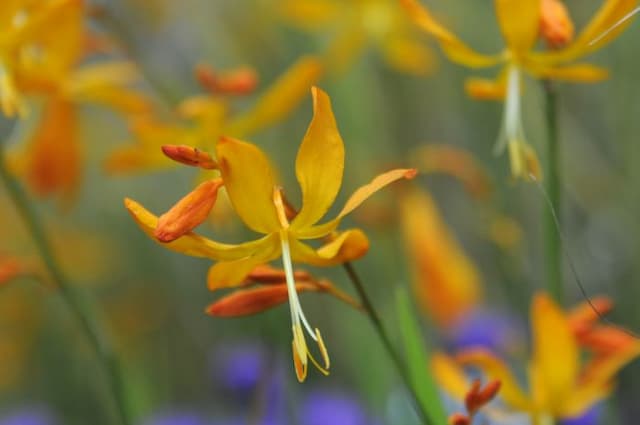
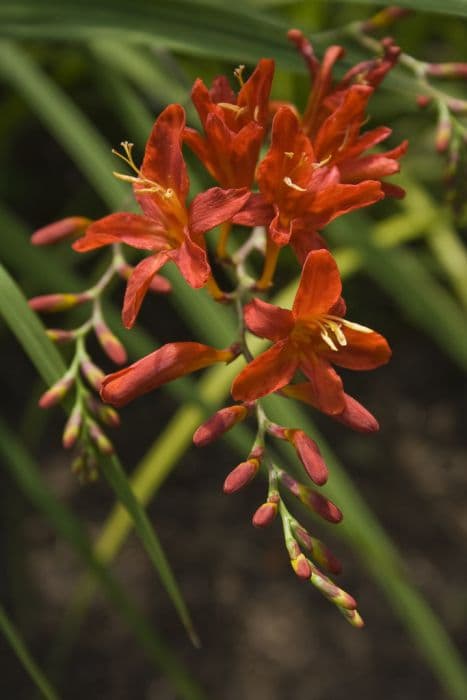
![Montbretia [Bright Eyes]](/_next/image?url=https%3A%2F%2Fplants-admin.emdemapps.com%2Fimages%2Fplants%2F%2Fimages%2F604b5f4a483b6.png&w=640&q=75)
